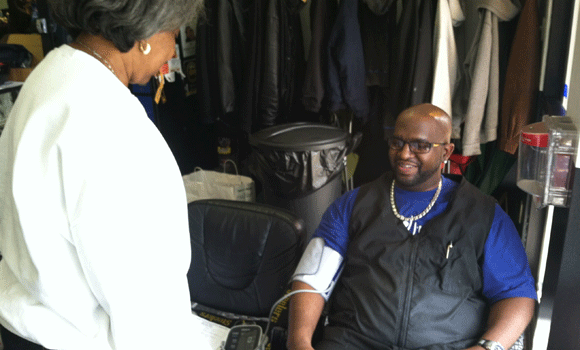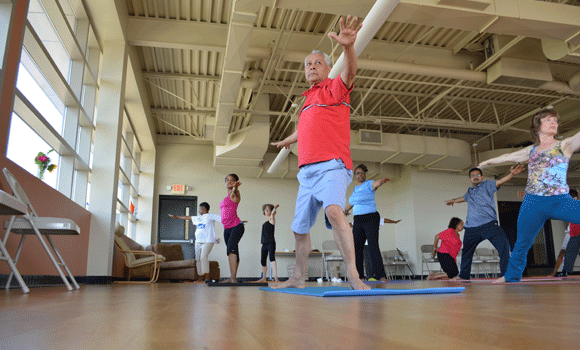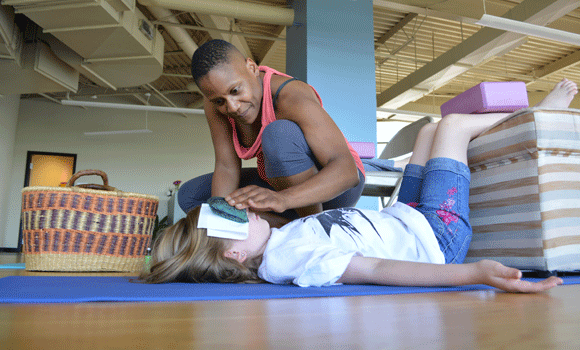In a neighborhood like Shadyside — with a Whole Foods on one corner, Giant Eagle Market District on the next, and nicely paved sidewalks in between — a healthy lifestyle with fresh produce and a nightly jog is a choice.
But for some communities, high crime rates and a lack of access create barriers to wellness. The Hill District finally gained a grocery store last year after three decades without. According to a study by the Allegheny County Department of Human Services, 14 percent of all homicides in Allegheny County occurred in Homewood and 11 percent in the Hill District between 1997 and 2007.
Access to basic necessities isn’t distributed equally across communities, says Lora Ann Bray, manager of Community Partnerships, Education, and Training at the Center for Health Equity.
“For communities of color and other low-income communities, where you might share some of those concerns about safety, people are going to get off the bus or out of the car and go straight into their house,” explains Bray.
According to an infographic created by Families USA, African American adults are 60 percent more likely to be diabetic, 30 percent more likely to die from heart disease, 40 percent more likely to die from breast cancer, and 40 percent more likely to die from a stroke.
According to Bray, social conditions can negatively impact an individual’s behaviors and lead to health disparities. For instance, an individual cannot control the quality of the air in their neighborhood, access to fresh fruits and vegetables, or the safety of a neighborhood for walking and running.
“These are some social, higher-level things that cause one to alter their behavior accordingly to survive, but it also impacts the quality of their health,” says Bray. “Then you see this gap.”
Organizations throughout Pittsburgh are working hard to reach out to communities, promoting health and wellness, and mitigating these disparities in minority and underserved populations. They are expanding and adapting their programs to meet ever-changing needs.
Health Advocates in Reach
Bray’s main initiative, the Health Advocates in Reach (HAIR) program, has been around since 2002, but recently expanded its efforts. HAIR is a partnership between the Center for Health Equity at the University of Pittsburgh‘s Graduate School of Public Health and barber shops in predominantly African-American neighborhoods.
The program currently operates in East Liberty, the Hill District, Homewood and Oakland. Through HAIR, health professionals visit the shops to educate community members on different wellness issues and perform screenings for common conditions. In the future, Bray would like to expand the program to reach more neighborhoods, including Pittsburgh’s North Side.
This program comes as a much-needed endeavor in these neighborhoods to increase awareness and availability of proper medical care. While the people in more affluent communities, with access to resources and the know-how to set up online appointments or buy medicines for any conditions they may face (including the more personal problems such as erectile dysfunction for which websites such as https://www.blinkhealth.com/viagra may have the solution), do not often think twice about their health and wellness, it is the people of underserved communities that are in dire need of attention regarding comprehensive healthcare.
“It’s a wonderful venue to reach African-American men, which is a very large, continuous, underserved population,” says Bray. “For African-American men, some health behaviors will put them at an increased risk for having undetected conditions go longer and when they are detected they may be at a place where it might be either too late because it’s already gone far…or sometimes the condition may be that it will take a lot of remediation to get it under control.”
Bray selects health care professionals that will take the next step beyond screening and care about the people in the shops.
“Rather than having someone left with a lot of questions, the partners that we select are ones that are conscious, that are interested in working with the population for a change, for an improvement of their long-term health,” she insists.
In the past, the program brought health professionals into the barbershops a few times throughout the year and centered on a large event in April that coincided with National Minority Health Week and National Public Health Week, but the shop owners reached out with a request that the professionals visit on a more regular basis. In June, HAIR kicked off a monthly program.
“It shows that the [people in the] shops are conscious and aware of the importance of the health,” explains Bray. “Sometimes people think that because a population may be in an underserved area or their socioeconomic status might not be as high, that people may not be concerned about their health, but that’s not true.”
“Knowing what’s important and how you can take steps, and knowing what you can do as an individual, I think is empowering for people,” she adds. “They feel a sense of control over what’s happening, even if some of those larger social determinants are outside of their personal control.”
The Kingsley Center
The Kingsley Center in East Liberty serves more than 4,000 children, youth and senior members. With a rich 120-year history and membership hailing from 26 zip codes, the Center has core programming values of health and wellness; community and sustainability; education and training; and family services. Its programs work to incorporate physical activity and healthier diets.
Felicia Lane Savage, a community health worker, teaches seven yoga classes a week at the Center.
“We have seen our demographics change drastically here, which is really exciting,” says Savage. “It’s become much more global…Usually the folks who join here are looking for a family center, community center, type of fitness facility, with health and wellness being only part of our mission.”
The Kingsley Center also offers education and training. For instance, one program teaches community members skills for green jobs such as retrofitting homes or landscaping.
Several other initiatives aimed at overall wellness are housed at the Kingsley Community Center. For instance, the East Liberty/Garfield Family Support Center offers support to families with children five years and younger. Jeremiah’s Place, a 24/7 emergency childcare center, leases space at Kingsley, allowing parents to drop children off for a temporary stay when childcare falls through.
The Kingsley Center also holds nutritional workshops that help members explore healthier ways to eat. One class offered a lesson in turning traditional African-American cuisine vegan while another demonstrated green smoothie recipes.
The Food Bank came in for a session, showing individuals how to make the food it distributes healthier by adding fresh foods. Non-perishable items such as boxed mac and cheese can be improved with the addition of fennel or apple slices.
Savage is also interested in improving the mental health of members. She has hosted a workshop, Mental Health First Aid, that helps participants recognize signs of unrest and manage relationships with loved ones who may show these signs. Many people who go through mental health stresses end up needing medication to help manage their issues, with some using cannabis through bubblers to help achieve a calmer state, and others going for Citaprolam and similar traditional treatments. Having this workshop, however, provides another support option.
The Kingsley also holds a diabetes support group once a month.
“Folks that have diabetes or loved ones with diabetes come together and just support each other in terms of incorporating physical activity or incorporating healthier diets,” explains Savage.
Kingsley also aims to connect members to the services of outside organizations through the Urban Green Growth Collaborative. Each month, nonprofits and social service providers come to the center and introduce the community to the programs that they offer.
UPMC’s African American Cancer Program
According to Lyn Robertson, the Associate Director of Health Equity, Education, and Advocacy at the University of Pittsburgh Medical Center, what was once the African American Cancer Program has broadened its reach.
“We kind of dissolved that label, but our efforts are to the underserved communities,” she explains. “That includes race or ethnicity, lower socioeconomic status, the disabled, those with mental challenges, the underinsured or uninsured, and those that are in rural areas. We’re really trying to work very closely with as many of those populations as we can.”
However, much of the revitalized program’s efforts focus on the area’s largest minority population, African Americans. The aim is to provide education and screening, and to connect people to a medical facility if necessary.
“We actually develop collaborative relationships with the communities, so that we are not mandating or having the upper hand,” says Robertson. “We work with them so they identify to us what their needs are.”
Robertson and her colleagues talk to underserved communities about the early signs of cancer and its causes. Though many people think that cancer is hereditary, a very low percentage of cancer is genetic.
“We could probably eradicate a fairly large number of some cancers if we ate healthier, exercised, maintained our weight, and avoided smoking,” she adds.
But the most important thing is getting people in underserved populations to a medical facility where they can receive care regularly.
Betty Dowdy, outreach coordinator for the African American Cancer Program, organizes a faith-based African-American Cancer Support Group at the Hillman Cancer Center in Shadyside. The group, which has been meeting since 1994, began when African-American cancer survivors said that their needs weren’t being met in other groups.
Boasting about 25 active members, the group meets on the third Saturday of every month. The key is to let people know know they are not facing their battles alone.
“We have a phone line, so if somebody doesn’t come, then they’re on the phone calling,” says Dowdy. “They make themselves very available to old members and new members. They’re very accessible.”








